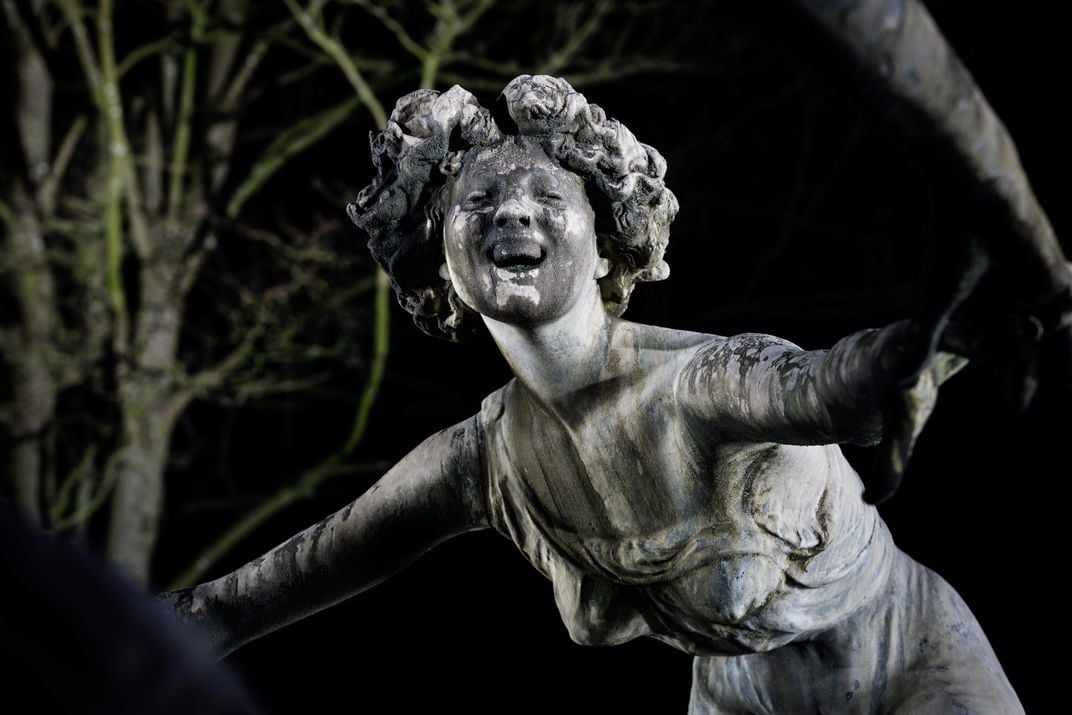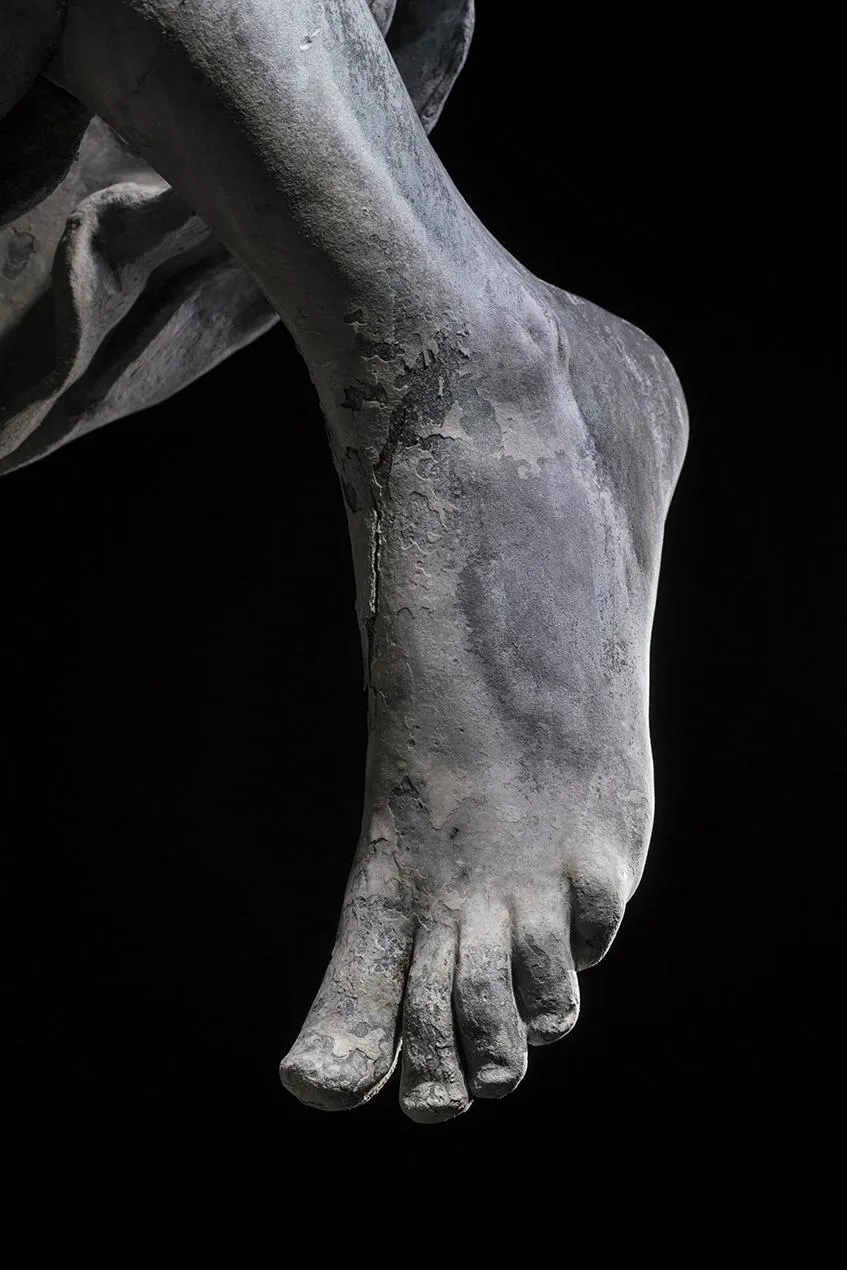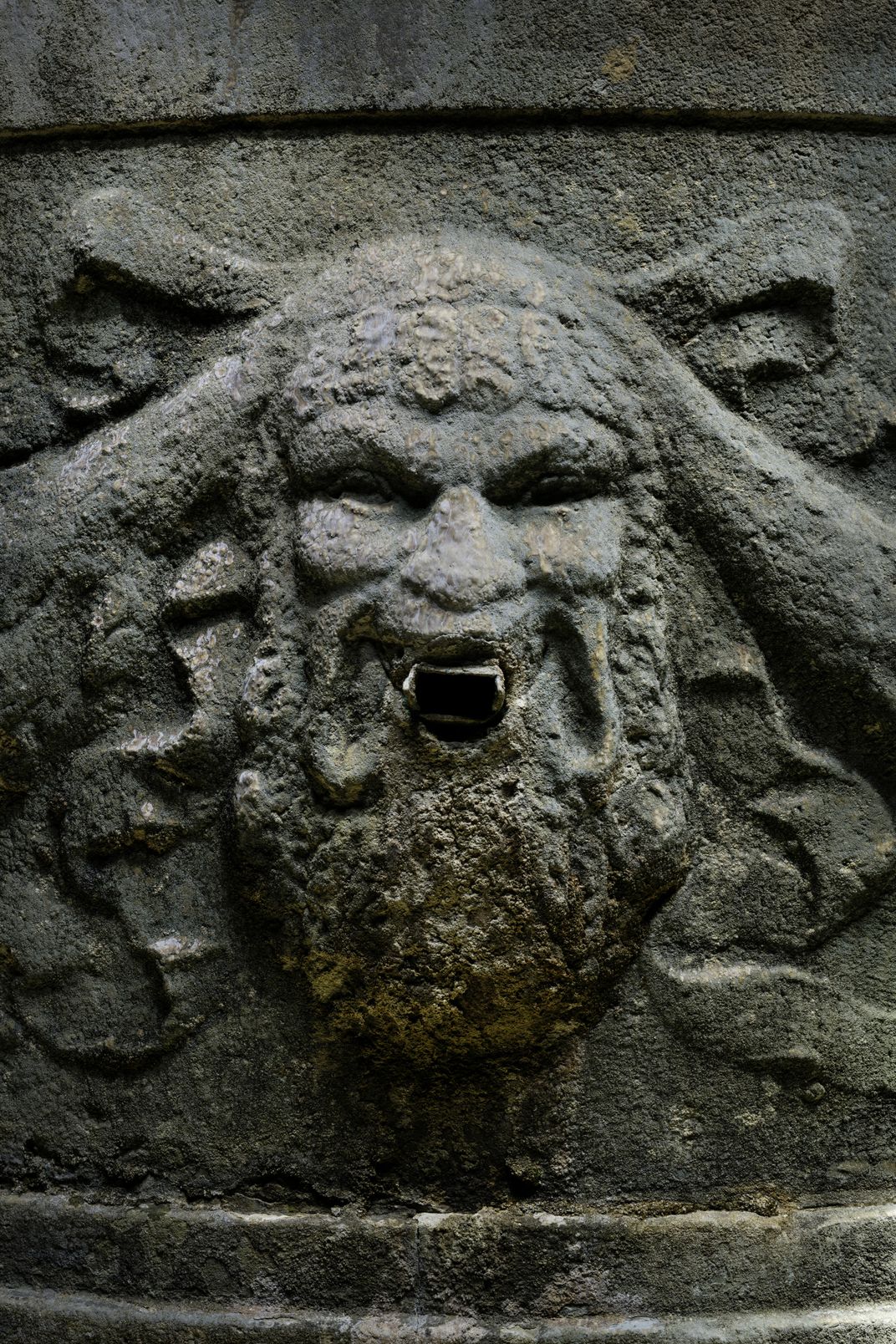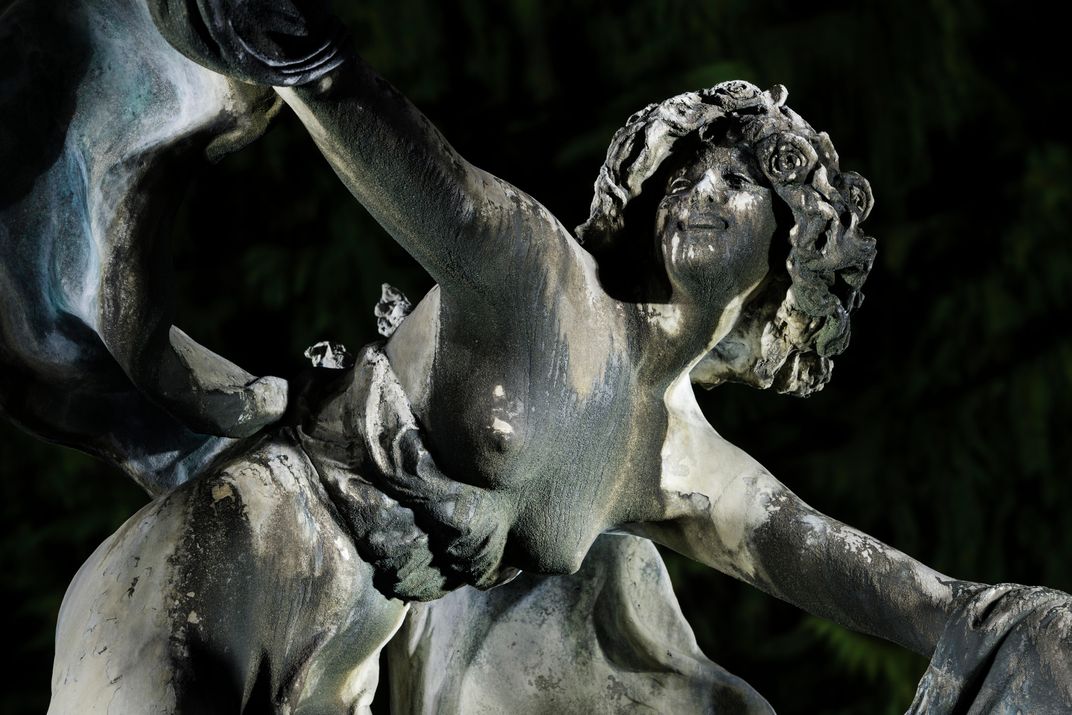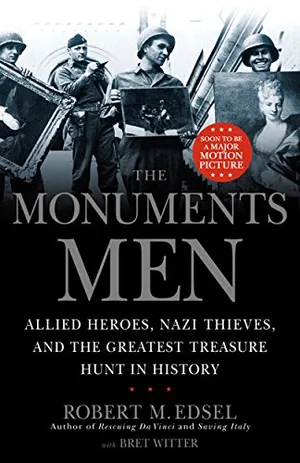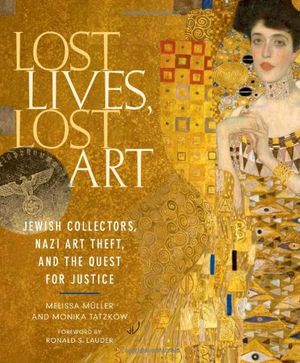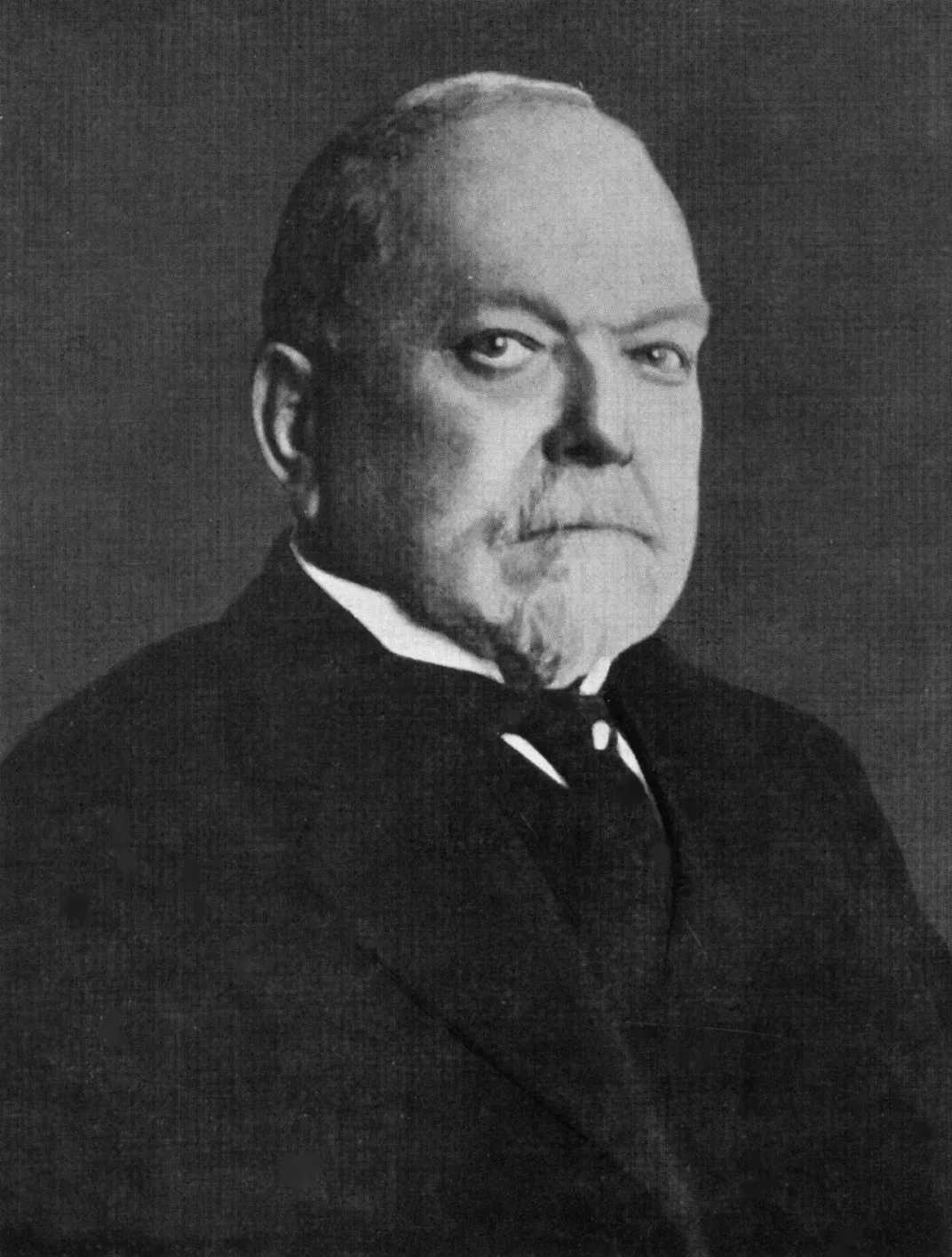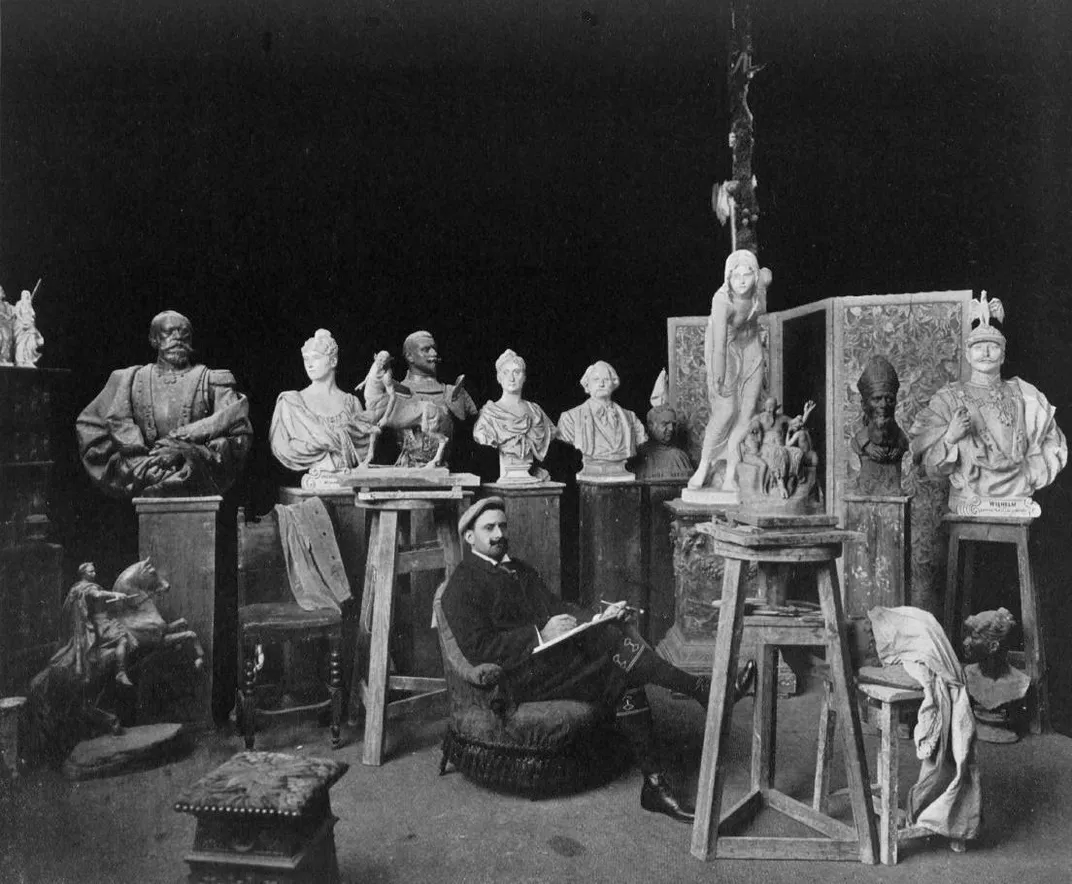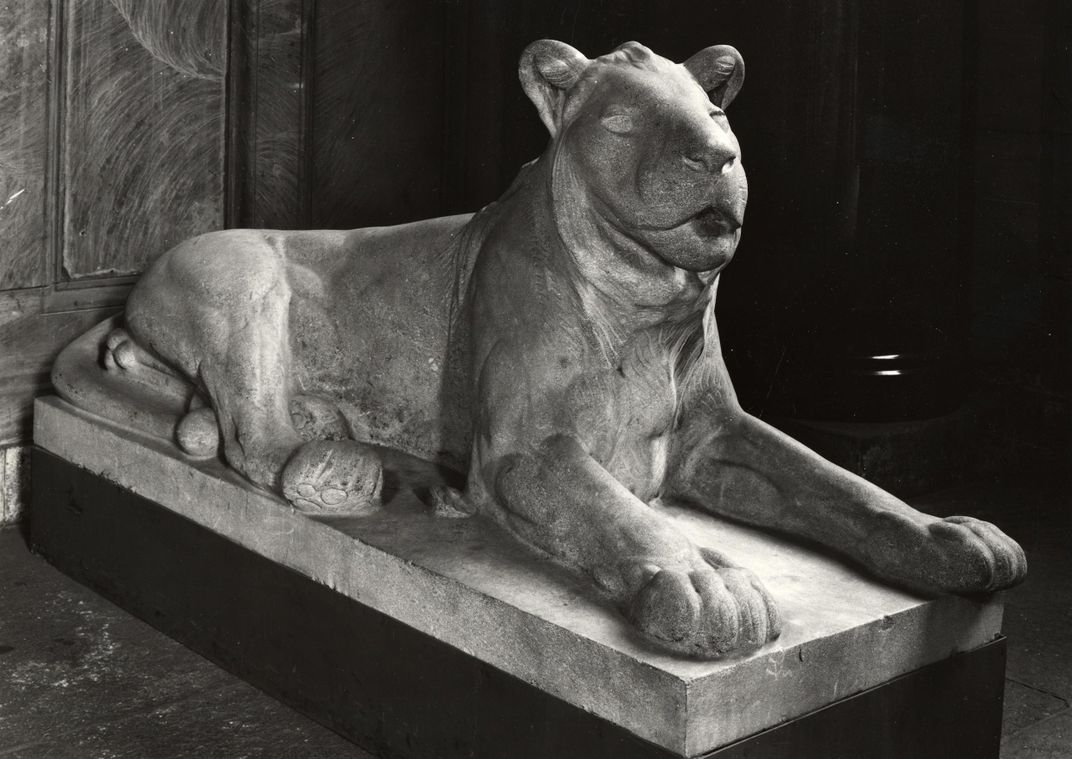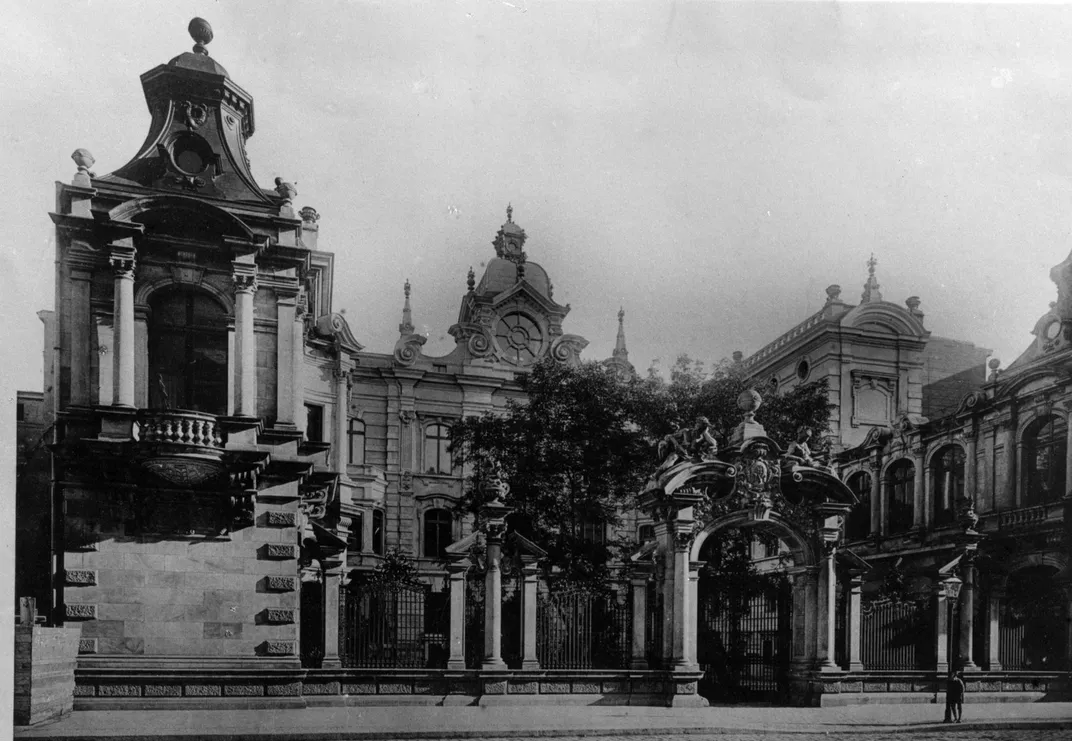The Lost Maidens of Berlin
A decades-long quest for one of the most intriguing artworks looted by the Nazis leads to the courtyard of a posh hotel in the German countryside
/https://tf-cmsv2-smithsonianmag-media.s3.amazonaws.com/filer/30/12/30127266-b46c-457d-b448-33f5c5cf4cd8/jun2018_i15_naziart.jpg)
In the final months of the 19th century, a German sculptor named Walter Schott began drawing up plans for a massive work he hoped would represent the pinnacle of his 15-year career. Cast in bronze, the Art Nouveau sculpture would feature three young women prancing around the lip of a stone fountain, fingers intertwined and mouths gleefully thrown open. Drei tanzende Mädchen, he would call it. Three Dancing Maidens.
Schott recruited a few local girls from his Berlin neighborhood, and asked them to dance around a peony bush. The resulting sketches, Schott later wrote in his memoirs, awakened in him an “enthusiasm I could no longer free myself from.” Still, the work came slowly. “To represent three very mobile figures atop a round, narrow disc, so that they make an impression when seen from all sides, has got to be one of the most difficult undertakings,” Schott recalled. He made a model at three-quarters scale, then another, then 35 more.
In early 1901, with his masterwork still in progress, Schott attended a gathering at a famous Berlin art salon. There, he struck up a conversation with a bell-shaped man in a fine black suit. Whether Schott had met Rudolf Mosse previously is unclear, but the artist would have known him by reputation. Born to a Jewish family in rural Posen province, in what is today Poland, Mosse had come to Berlin in the 1860s to work in publishing. By 24, he had his own advertising firm. Now 58, with thinning gray hair and a delta of crinkles between his arced brows, he was one of the wealthiest and most influential men in Germany—the head of a vast business empire that included some 130 newspapers, chief among them the Berliner Tageblatt, the daily of choice for Berlin’s intelligentsia.
Mosse had never been inclined to sit on his money, preferring instead, with his wife, to embark on philanthropic endeavors—one was the Rudolf and Emilie Mosse Foundation, a charity for poor children—and invest in a vast trove of rare books as well as artworks, which he hung, gallery style, in an opulent palace on Leipziger Platz: Egyptian antiquities, Benin Bronzes, paintings by giants such as the German Realist Adolph von Menzel and the Flemish master Peter Paul Rubens. Writing almost a century later, Rudolf’s grandson George would remember that Rudolf, a self-made Jew in a land of Gentiles, found validation in his world-class art collection: It was “a sign of [the family’s] integration into European history and tradition.” On weekends, left-leaning politicians and writers gathered in the banquet hall of the Mosse Palais to drink and debate under a mural by the famed German historical painter Anton von Werner; now and then, Mosse would throw open the manor doors, allowing the public to wander the halls.
But Mosse felt something was missing from the residence, and turning to Schott, he said that he happened to be in the market for a fountain for the courtyard of his Berlin home. Might Schott have any suggestions? No record exists of Schott’s reply, but a letter, sent to Mosse a few days later, has survived. “Your idea has inspired me so much,” Schott wrote, adding that he did indeed have a design that might appeal to Mosse. “If it interests you,” Schott went on, he would be pleased to have Mosse pay him a visit at his studio, “without any liability for you.”
Eight years later—an agonizing period for Schott, a perfectionist who was determined that his sculpture should be impeccable—the finished piece was hauled by a team of workers to the Palais and connected to a freshwater well under the courtyard floor. With his sculpture occupying some of the best real estate in the city, Schott’s reputation soared; in short order, he won the gold medal at the 1910 world’s fair, in Brussels. He was forever grateful. “How faithfully in my heart I preserve the memory of my generous, art-loving patron Rudolf Mosse, my good friend,” he enthused in his memoirs.
But his benefactor had a limited time to enjoy his purchase. In 1914, World War I threw the city into chaos, and in 1920, Mosse died, of natural causes, at the age of 77. His businesses passed into the hands of his daughter, Felicia Mosse, and her husband, Hans Lachmann-Mosse, who attempted to steer the Mosse empire through the spasms of the postwar economic collapse.
With the rise of the Nazi Party in the 1930s came more urgent dangers. To the Nazis, a media empire run by liberal Jews was a grave offense and a threat, and the Reich frequently singled out the Mosse family as a public menace. In March of 1933, Berliner Tageblatt was blocked from publishing for several days “in the interests of public safety and order,” a Nazi official declared, and the paper’s editor, Theodor Wolff, a vociferous critic of Joseph Goebbels, was forced into exile. (The paper was eventually shut down entirely.)
That same month, Hans Lachmann-Mosse was visited by Wilhelm Ohst, a Nazi officer. With a revolver reportedly placed on the desk between them, Ohst explained that effective immediately the entirety of the Mosse family’s assets would be signed over to a fund benefiting veterans of the First World War. The foundation was a sham, but implicit in Ohst’s “offer” was survival for Lachmann-Mosse and his wife and children, who would be allowed to leave Germany alive.
The next year, the Nazis hired a pair of Berlin auction houses to dispose of the Mosse art collection, and in 1936 the Palais was rebranded as the headquarters of the Academy for German Law, a kind of Nazi think tank run by the vicious anti-Semite Hans Frank, later the governor of Nazi-occupied Poland. (Frank, who oversaw the murder of hundreds of thousands of Polish civilians and millions of Polish Jews, was executed in 1946 by the International Military Tribunal at Nuremberg.)
One of the last surviving photographs of the old Mosse Palais was taken in 1940, during an architectural survey carried out by the Reich. In the picture, Schott’s sculpture has been replaced by a stone lion, also from the Mosse collection, presumably because the lion was viewed by Nazi officials as a more fitting mascot for the Academy.
Five years later, the Red Army cascaded through the gates of Berlin, raising a Soviet flag over the Reichs-tag, and reducing the nearby former residence of Rudolf Mosse to rubble. The lion was recovered, bruised but intact.
The fountain was gone.
**********
The case of Rudolf Mosse’s missing bronze fountain may seem, in the hierarchy of high-profile art crime, to be a relatively minor mystery, lacking the sheen of intrigue that surrounds major heists or masterful forgeries. Outside of art history circles, Drei tanzende Mädchen isn’t even particularly well known. But inside them, and especially among restitution experts, the sculpture represents a superlative example of the time, energy, money, doggedness and old-fashioned expertise required to track down a missing piece of art. And it stands as a heart-wrenching test of the limits of legal solutions to crimes in which the burden of restitution isn’t always clear.
On a gray morning last spring, I took a taxi out to the Freie Universität, or Free University, on the southwestern edge of Berlin, and climbed a spiral staircase to a third-floor office in the art history department, to learn more about the case. A professor named Meike Hoffmann met me at the landing, looking happy but frazzled. Hoffmann, in addition to her duties as a lecturer, serves as the manager of both the Research Center for “Degenerate Art” (the label the Nazis gave to avant-garde Modern work) and the Mosse Art Research Initiative, or MARI, a collaboration between the university, close to a dozen museums and archives and the surviving heirs of the Mosse family.
MARI is one of a growing cohort of groups dedicated to identifying and, when appropriate, restituting artworks seized by the Nazis. Some of those initiatives, like the German Lost Art Foundation, which was established by the German government in 2015 and is a partner to MARI, have a broad mandate to support looted-art provenance research and public education. Others are more focused, like MARI. Its goal is to identify and locate each of the hundreds of artworks stolen from the Mosse family; as a neutral research initiative, it doesn’t take stances on questions of restitution, but in some cases the Mosse heirs use the group’s findings to press claims of restitution on their own. “Part of what I love about the job,” Hoffmann said, “is being able to recover these pieces of history—these missing puzzle pieces.”
She showed me into the office that serves as MARI headquarters. The space was brightly lit and airy, the lone decoration a few sheets of paper tacked to the far wall. I leaned in to look.
“Floor plans of the Mosse Palais,” said Michael Müller, MARI’s database expert. Using old photographs and private collection catalogs, the MARI researchers had penciled in the locations of a handful of missing artworks; contemporary newspaper articles and memoirs by Mosse family acquaintances helped to place others. There was plenty of white space. “A work in progress,” Müller said, smiling.
That artworks stolen by the Nazis should be returned to their rightful owners is, of course, not a new idea. Think of the Monuments Men, the Allied task force established in 1943 to track down more than five million paintings, sculptures and other cultural artifacts swept up in the war. And through the 1950s and 1960s, Jewish families frequently sought, albeit with limited success, to recover art that had been dispersed across the radically redrawn geography of postwar Europe.
The Monuments Men: Allied Heroes, Nazi Thieves, and the Greatest Treasure Hunt in History
At the same time Adolf Hitler was attempting to take over the western world, his armies were methodically seeking and hoarding the finest art treasures in Europe.
MARI is a newer phenomenon, a product of what Nicholas O’Donnell, a Boston-based lawyer and author of the 2017 book A Tragic Fate: Law and Ethics in the Battle Over Nazi-Looted Art, describes as a “domino line” of developments: the emergence of the Internet, which has massively facilitated the search for stolen items; Germany’s increased willingness to reckon with Nazi crimes; and a growing international consensus that museums, galleries and private collectors possessed far more looted art than was generally acknowledged.
In 1998, representatives from 44 countries convened in Washington, D.C. to sign the “Washington Conference Principles on Nazi-Confiscated Art,” an 11-point blueprint for the restitution of looted art that encouraged research into artworks acquired just before, during and immediately after the war. In the United States, auction houses like Sotheby’s created in-house provenance research teams; the German government itself formed a Lost Art Database to document missing assets (now overseen by the Lost Art Foundation).
Several high-profile successes followed. In 2000, the North Carolina Museum of Art agreed to return to an Austrian family a 16th-century painting by Lucas Cranach the Elder, which had been confiscated by Nazi officers in 1940. But a turning point was the long shot, but ultimately successful, legal challenge waged by Maria Altmann, a Jewish refugee from wartime Vienna, against the Austrian government for the return of six Gustav Klimt paintings once owned by her family. In 2006, after years of heated proceedings in Austria and the United States, including a surprise decision by the U.S. Supreme Court, Altmann was awarded five of the six paintings in binding arbitration, and a new precedent was set for the jurisdiction of American courts to determine ownership of artworks claimed even by foreign governments. (The saga was the subject of the book The Lady in Gold and a 2015 movie starring Helen Mirren.)
“You have this compounding public interest in restitution,” O’Donnell says. “And people start to understand that there’s no end to these cases, that so many collections were affected, and so much of that art is still out there.”
**********
It was after the success of the Altmann case that Roger Strauch, the son of Lachmann-Mosse’s stepson and the president of the Mosse Foundation, decided to pursue a restitution initiative of his own. “It just felt to me like the timing was right,” Strauch told me recently from his home in California.
Growing up, Strauch had heard stories of how Hans Lachmann-Mosse escaped first to Switzerland, then to Paris and on to the States, and of everything he’d left behind. In the 1990s, George Mosse, Hans and Felicia Lachmann-Mosse’s son—by then a revered professor of European history at the University of Wisconsin—had won back from the former East German owners many properties the Mosse family had lost to the Nazis, including the site of the old Palais, which has since been redeveloped as a mixed-use business and apartment complex. But the art that had covered the walls was still missing.
“I was thinking, OK, how am I going to handle this?” Strauch recalled. He’d seen how much effort it had taken Altmann to pry her art away from the Austrians. “I wanted to do it in a way that would surprise people,” Strauch went on. “I said, Let’s see if we can do this in a way that’s less contentious, more collaborative, and perhaps more expeditious.” (The Mosse beneficiaries would include a great-granddaughter of Rudolf Mosse, who has asked to remain anonymous, the Mosse Foundation and the University of Wisconsin, to which George Mosse bequeathed his portion of the family’s estate.)
Lost Lives, Lost Art: Jewish Collectors, Nazi Art Theft, and the Quest for Justice
This real-life legal thriller follows works by Rembrandt, Klimt, Pissarro, Kandinsky, and others.
One of Strauch’s first moves was to obtain the services of the white-shoe law firm Bartko, Zankel and Bunzel, of San Francisco, and to name J. Eric Bartko, a veteran investigator and the son of the firm’s co-founder, as the head of the project. Bartko, in turn, hired several private detectives. “In the past, heirs didn’t have the whole history of expropriation,” Bartko told me. “We would.”
Using catalogs from the Nazi auctions of the Mosse art collection, Bartko compiled a list of more than 1,000 works, including descriptions whenever possible. “And then we got lucky,” Bartko said, “because just as we’re finishing drawing up the list, the stuff with Gurlitt happens.”
In 2012, authorities in Munich raided the apartment of an elderly man named Cornelius Gurlitt, whose father had been an art dealer with close ties to the Nazi regime. Investigators found an unrivaled trove of more than 1,200 artworks—plus another 200-odd works at a second home, in Austria—including masterpieces by Picasso, Monet, Matisse, Renoir, Chagall and others. Together the collection was estimated to be worth more than $1 billion. (Gurlitt died in 2014, at age 81. In a sign of how difficult restitution can be, just six of the works have since been returned to the heirs of their rightful owners.)
The discovery of Gurlitt’s secret cache, made public in November 2013, dominated front pages in Germany for months. “What the Gurlitt case did,” a German art lawyer told me, “was cement this notion that the question of looted art in our country wasn’t resolved. Not even close. And there was just an enormous push, driven by the media, to increase the amount of research being done.”
Around this time, Eric Bartko received an unusual call from a man named Wally Mersereau, who had found Bartko's name on a website about the Mosse family. A wealthy investor from Northern California, Mersereau was also an amateur researcher, and he had information he thought Bartko might find interesting.
Several years earlier, on a trip to New York, Mersereau had been strolling through the Conservatory Garden, in Central Park, when he found himself facing a large bronze sculpture of three dancing girls. He leaned in to examine the plaque: “This fountain erected in memory of Samuel Untermyer, 1858-1940, and Minnie Untermyer, 1859-1924.” No other information was listed. Back at home, Mersereau did a little Googling, and learned that the sculpture had been designed by a German artist called Walter Schott, and before coming to Central Park it had stood on the grounds of a Yonkers, New York, estate owned by Samuel Untermyer, a prominent lawyer.
Intrigued, Mersereau embarked on a remarkable freelance investigative project. He hired a German researcher to translate parts of Schott’s memoirs, which hadn’t been in print for decades, and over the course of two years tracked down six versions of Drei tanzende Mädchen: an original, created on commission for Rudolf Mosse; two other full-size casts; and three versions at three-quarters scale.
Mersereau was so enchanted by the sculpture that he decided to travel around the world, on his own dime, to inspect each one for himself. He found one of the smaller versions in a park in Northern California, another in a park in the Austrian Alps and the third in a garden in Berlin. The full-size versions were in New York’s Central Park, in Antwerp’s Den Brandt Park and in the courtyard of the Burg Schlitz castle, a grand old hotel in the Mecklenburg region of northern Germany.
Which was the original, the one the Nazis stole from Mosse? Mersereau was sure it wasn’t the Untermyer Fountain in New York—records from Schott’s workshop showed that it had gone straight to the Untermyer estate. Furthermore, the Antwerp fountain had been installed around 1911, and had never left the park grounds. That left the sculpture at the German hotel.
Mersereau went to Mecklenburg to meet with a local historian and retired forester named Jürgen Lutt-mann. Speaking through a translator, Luttmann explained that the hotel at Burg Schlitz had not always been a hotel—it was built as the summer residence of a 19th-century count named Hans von Schlitz, and was purchased in the 1930s by Emil von Stauss, a close friend of the high-ranking Nazi leader Hermann Göring.
Luttmann produced a loose-leaf binder full of handwritten notes. Years earlier, he said, he’d interviewed a local man who told him that, in 1937, von Stauss had paid him to drive a bronze sculpture from Berlin to Burg Schlitz.
“Where in Berlin?” Mersereau asked.
“I was told it came from the home of a publisher,” Luttmann responded.
Eric Bartko listened to Mersereau’s story with growing excitement. “To me, it was really straightforward,” Bartko told me. “It was a process of elimination. There are three full-size sculptures, right? And we now knew where two of them were, and how they got there. That brings you directly to the original statue.” Bartko learned that the hotel at Burg Schlitz had recently been sold to a man named Armin Hoeck, who had worked in five-star establishments as a manager and director and appeared to be making his first foray into ownership.
By this time, Bartko and his investigators had ferreted out what they believed to be the locations of more than 30 artworks from the Mosse collection. Lady with Red Blouse, a forlorn canvas by Adolph von Menzel, was at the Oskar Reinhart Foundation, in the Swiss town of Winterthur. A small painting depicting Rudolf Mosse as a Renaissance-era patron, surrounded by family dressed in period costume, was at the Jewish Museum in Berlin. A lion sculpture by a founder of the Berlin Secession movement, August Gaul—the same one that replaced Schott’s fountain in the Palais courtyard—was at the city’s Staatliche Museen, as was Susanna, an elegant 1869 sculpture by Reinhold Begas.
Working with German attorneys, Bartko wrote to museum directors requesting provenance reports on the objects he’d linked to the Mosse collection. As Jan Hegemann, a tall and ruddy-cheeked Berliner and attorney for the Mosse family, told me over lunch last summer, they encountered little resistance: Bartko had produced what amounted to a series of unassailable claims. What was more, the Prussian Cultural Heritage Foundation, which runs more than a dozen of Germany’s museums and research libraries and was then in possession of Susanna and the Gaul lion, would go one step further and launch a full internal review of its collections. (It would unearth eight additional Mosse-owned artworks in its possession.) In each instance, a deal was struck: The work was either restituted to the Mosse heirs and then repurchased by the foundation or, based on a loan agreement, allowed to be kept on view with a placard indicating its provenance.
Bartko drafted an email to Hoeck, explaining what he’d learned about the Schott fountain. “In accord with the Washington Principles,” he wrote, “the Foundation would like to enter into a private discussion with the appropriate officials of Burg Schlitz in order to reach an agreement on the appropriate restitution” of the sculpture.
Hoeck never responded.
**********
In the past year, MARI has opened investigations into 40-odd additional pieces from the Mosse collection, and has located six Mosse-owned paintings in museums in Germany, Austria, Switzerland and the U.S. as well as in private collections. When I visited, Hoffmann and the other researchers were in high spirits: They’d discovered that a painting of a funeral scene by the 19th-century Dutch artist Jozef Israels, titled From Darkness Towards the Light, was hanging in a museum in Tel Aviv. “We’ve been exchanging emails with the curators there,” Hoffmann said. “It’s encouraging.”
Michael Müller, a data visualization expert, led me over to his desk and opened the MARI portal, a computer database. While I watched, he clicked on the file for From Darkness Towards the Light. The first entry contained results from an image search that led the MARI researchers to the Tel Aviv Museum of Art’s online catalog. Another entry included photographs the museum sent to MARI showing two stickers on the back of the painting, one identifying the year of the painting’s completion (1871) and another a name (J.S. Forbes). Several days of hunting in 19th-century auction catalogs turned up the next clue: James Forbes, a wealthy Londoner, had purchased the canvas at auction in 1874. By 1905, the canvas was in the possession of the Galerie Heinemann, in Munich, and the next year Rudolf Mosse purchased it for the equivalent of about $7,000.
The next few entries in the dossier featured computer-enhanced comparisons of the painting in the Tel Aviv collection and a photograph from the 1934 Mosse auction catalog. Müller zoomed in on a shot of the painting. By layering a grid of red lines over the photographs, he had found that the dimensions of the paintings were identical, as were the irregularities.
“A match,” I said.
“Oh yes,” he responded.
After Müller was finished, I sat down with Claudia Marwede-Dengg, MARI’s lead on the Drei tanzende Mädchen investigation. Unlike Bartko, Marwede-Dengg was not prepared to wholeheartedly accept Mersereau’s findings. For one thing, the statement from Luttmann, the former forester, was just hearsay: the story of a man who claimed to have been paid to take a sculpture to Burg Schlitz more than 50 years earlier. “As historians,” Marwede-Dengg said, “we want the documents.” Marwede-Dengg made her own inquiries in Mecklenburg, and was informed Luttmann had since died.
Meanwhile, the hotel’s website began to promote an alternate history for the sculpture: It had been purchased by Emil von Stauss from the Wertheim’s department store, in Berlin. “It doesn’t make sense,” Marwede-Dengg said. No photographs of Wertheim’s show anything resembling Drei tanzende Mädchen, and there’s no mention of a sale to Wertheim’s in Schott’s memoirs.
Poring over copies of the Mosse auction catalogs at a Berlin library, Marwede-Dengg spotted a small notation, in pencil, for brunnen, or fountain, with a price of 55 Reichsmarks, or about $22 U.S. (The notation had appeared only on that particular copy of the catalog, and had thus been missed by Bartko and his investigators, who consulted different versions.) There was no sign of who, if anyone, had bought the fountain. But was it possible, Marwede-Dengg wondered, that the sculpture had been sold cheap to von Stauss, a Nazi ally then in possession of Burg Schlitz, so the Academy could clear the courtyard for the lion it planned to install in its place?
Marwede-Dengg explained that she planned to continue her research: Different libraries kept different files, and she might yet turn up more of Schott’s correspondence or even—the holy grail—transport papers documenting a transfer from the Mosse Palais. But I asked her whether, even short of that, she felt confident the sculpture at Burg Schlitz was the original.
She did not hesitate. “Yes,” she said.
**********
To reach Burg Schlitz from Berlin, you head northwest out of the city on the smooth asphalt of Highway 24, and then due north through the rumpled farmland of Mecklenburg, toward Lake Malchiner. From there, it’s a 15-minute drive along knotted county roads, overhung with ancient oak boughs, to the grounds of the hotel.
The day I made the trip was warm but gray. As I stepped out of my rental car, the skies cracked open, pelting the flanks of the castle with rain. I ran in the direction of the garden, and past the ground-floor café, where a group of beer drinkers were huddled under umbrellas. Thirty seconds later, I was standing in front of Drei tanzende Mädchen.
I could see, up close, why the artist had been convinced that the sculpture would be his masterwork: The sense of movement was extraordinary. The piece breathed as a painting could not. I thought about the decades Drei tanzende Mädchen had sat quietly in the shadow of Hoeck’s hotel.
Hoeck and the Mosse lawyers had lately entered into an increasingly contentious legal correspondence. Writing through his attorney, Hoeck argued he could not be certain his fountain was Mosse’s fountain; moreover, even if it was, who was to say it had actually been stolen? After all, Hoeck’s attorney wrote, the Mosse family had been in financial trouble before the Nazis took power. Wasn’t it possible that the collection had been sold legitimately?
This, predictably, infuriated the Mosse lawyers: In the 1950s, and again in the 1990s, after German reunification, German authorities established unequivocally that the Nazis had illegally confiscated the Palais and other Mosse properties. (All the historians I spoke to for this story agreed that there is no question the confiscated items from the Mosse art collection meet the criteria for looted art.)
“I am adamant about the accusation that your client is a profiteer of Nazi loot,” Hegemann, the Mosse family attorney, shot back in a letter to Hoeck’s legal representative. “I don’t reproach him for not having known about the circumstances when he purchased the premises of Burg Schlitz. However, today Mr. Hoeck is well aware of the issue and he benefits from Nazi-confiscated property. I don’t know what else to call that behavior.”
Yet Hoeck has the upper hand in a very important way: Under German law, museums can be compelled to return art lost to persecution by the Nazis. Individuals cannot be, as long as they were not themselves part of the theft, and received the object secondhand, in an auction or private sale, without knowledge of its true origin.
Hoeck, for reasons that can only be speculated about, has chosen to fight the accusation, retaining an attorney and digging in his heels. In 2016, he gave his only interview about the fountain, to a local Mecklenburg publication, in which he was insistent that there is nothing he can do to determine the origin of the sculpture. “I am not an art historian, or a historian,” he said.
Then he went a step further. When asked what he knows about how the Nazi ally who owned the castle in the 1930s came into possession of the sculpture, Hoeck said, “I don’t know how Emil von Stauss acquired the fountain. I don’t know if it would be ‘clean’ according to today’s concept of moral values.” About the Mosse heirs, however, he was more certain: “They’re trying to extort money from us,” he said. They “want money, but they won’t get any from me.”
At Burg Schlitz, I wandered back up the hill and into the hotel’s reception area. The room had the stately grace, the airlessness, of a historical museum. The couches looked unused.
“Hi,” the receptionist said in crisp English. “Reservation?”
“I was hoping to speak to Mr. Hoeck,” I said.
“And you are?”
I told her I was a reporter from the United States, and that I’d emailed Hoeck multiple times before coming to Germany. I’d never received any answer.
The receptionist retreated into a small office and approached a man sitting inside. From photographs I recognized the graying, swept-back hair and stylish round glasses—it was Armin Hoeck. There was a lengthy conversation in German, and then the receptionist returned.
“He’s in a meeting,” she said.
“I can wait,” I said.
“It will be several hours. What is this about, anyway?”
I mentioned the fountain. The receptionist was no longer smiling. “As far as I know,” she said, “everything is in order.” Then she waved goodbye, and escorted me through the door, pulling it shut behind me.
After I returned from Germany, I tried again on several occasions to reach Hoeck, by phone and by email. He never responded. Recently, I submitted a final request, through Hoeck’s attorney, for an interview. “My client generally does not give interviews on the matter you mentioned,” he replied, “and I am not authorized to comment either.”
When I last spoke with Marwede-Dengg, MARI’s lead on the Drei tanzende Mädchen investigation, she remained cautiously hopeful that MARI would find a way to establish the provenance of the fountain at Burg Schlitz beyond a doubt. Although the sculpture itself might have twins elsewhere in the world, the stone base would be unique. Perhaps there was a way to trace the type of material and origin of the plinth, Marwede-Dengg mused, growing animated. Using that kind of analysis, you could establish a date of crafting, and from the date, another solid clue as to its origins.
Marwede-Dengg sighed. “Of course, that could take a long time, and the owner—he’d have to give us permission,” she conceded. “Which, right now, he doesn’t want to do.”
Missing Pieces
Numerous artworks plundered by the Nazis have been properly restituted, but thousands more are unaccounted for—or are tied up in legal challenges. Here are five superlative paintings that have been returned to their rightful owners, and five whose status is contested today .
Gustav Klimt, Portrait of Adele Bloch-Bauer I, 1907
/https://tf-cmsv2-smithsonianmag-media.s3.amazonaws.com/filer/9d/0b/9d0ba9e9-ac08-4bde-b5d0-acd09be648e3/jun2018_i08_naziart.jpg)
RESTITUTED
Also known as The Woman in Gold, Klimt’s celebrated painting, now at the Neue Galerie in New York, was at the center of Maria Altmann’s 2006 court victory over the Austrian government.
Paul Klee, Swamp Legend, 1919
/https://tf-cmsv2-smithsonianmag-media.s3.amazonaws.com/filer/80/8b/808b3df6-63e1-4065-9887-dee0dee22f1d/jun2018_i10_naziart-wr.jpg)
RESTITUTED
Germany’s longest-running legal challenge over looted art was settled in 2017 after 26 years. The city of Munich paid the former owner’s heirs market value for the painting, which will remain on view at the Lenbachhaus museum.
Johannes Vermeer, The Astronomer, c. 1668
/https://tf-cmsv2-smithsonianmag-media.s3.amazonaws.com/filer/94/fd/94fdf7ed-1690-4cb6-aa19-6fc398cd8327/jun2018_i09_naziart.jpg)
RESTITUTED
The Nazis seized this Dutch masterpiece from the Rothschild family. Returned after the war, it was acquired by the French state in 1983 and has been at the Louvre ever since.
Claude Monet, Water Lilies, 1904
/https://tf-cmsv2-smithsonianmag-media.s3.amazonaws.com/filer/e5/0d/e50d8c9f-5dc5-414b-ad45-8d2a342c8feb/jun2018_i18_naziart.jpg)
RESTITUTED
In 1940, hundreds of paintings by Matisse, Degas and others were stolen from Paul Rosenberg, a French-Jewish art dealer. This Monet was returned to the Rosenberg family in 1999.
Anonymous, The Raising of Lazarus, c. 1530-1540
/https://tf-cmsv2-smithsonianmag-media.s3.amazonaws.com/filer/cb/05/cb05ed27-b7c1-4636-a779-f5ec814ff575/jun2018_i17_naziart.jpg)
RESTITUTED
This Renaissance work, seized in 1938, ended up in Hermann Göring’s private collection of more than 1,000 paintings, primarily works stolen from Jews. The painting was finally restituted in 2017 to the heirs of financier Gerson von Bleichröder, once adviser to Otto von Bismarck.
George Grosz, Poet Max Herrmann-Neisse, 1927
/https://tf-cmsv2-smithsonianmag-media.s3.amazonaws.com/filer/2b/b9/2bb9e721-908b-46d4-b164-2ad473430dee/jun2018_i16_naziart.jpg)
CONTESTED
This is one of three paintings by Grosz now at New York’s Museum of Modern Art that his family claims were confiscated. In 2011, a federal judge dismissed a lawsuit by Grosz’s heirs; German law supports the family’s case.
Amedeo Modigliani, Seated Man with a Cane, 1918
/https://tf-cmsv2-smithsonianmag-media.s3.amazonaws.com/filer/17/11/171199c9-2957-445b-8faa-7e576ae1d696/jun2018_i07_naziart.jpg)
CONTESTED
Swiss authorities are investigating this canvas, which the 2016 “Panama Papers” revealed was secretly purchased by an international art dealer using a shell company
in Panama.
Pablo Picasso, Seated Woman with a Book, 1910
/https://tf-cmsv2-smithsonianmag-media.s3.amazonaws.com/filer/18/5c/185cacfd-c1ad-4aba-b71c-552ae1d05e6f/jun2018_i02_naziart-wr.jpg)
CONTESTED
This past March, the Rhode Island School of Design denied claims by heirs to art collector Alphonse Kann that this Picasso was among 1,200-odd paintings ransacked by the Nazis in 1940.
Lucas Cranach the Elder, Adam and Eve, c. 1530
/https://tf-cmsv2-smithsonianmag-media.s3.amazonaws.com/filer/99/f7/99f73f0f-3bcb-4560-a0df-23bcaa2ce990/jun2018_i05_naziart-wr2.jpg)
CONTESTED
This pair of Renaissance masterpieces remains on view at the Norton Simon Museum in Pasadena, California, after a 2016 U.S. court ruling affirmed the museum’s ownership. The former owner’s heirs have appealed.
A Note to our Readers
Smithsonian magazine participates in affiliate link advertising programs. If you purchase an item through these links, we receive a commission.
